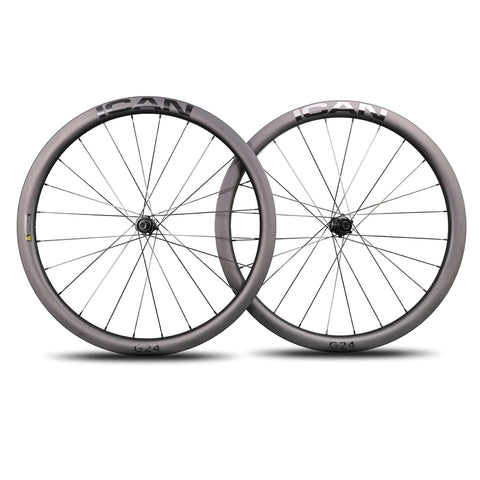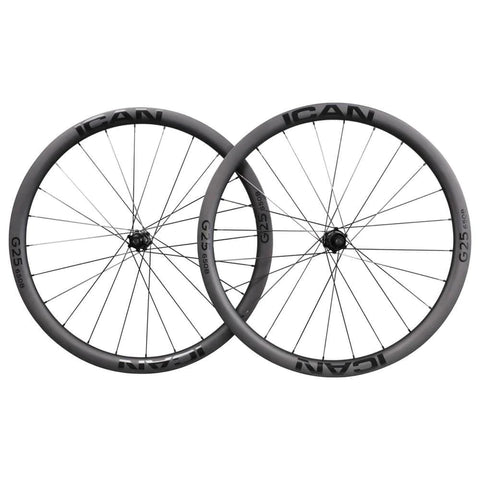A gravel bike is a type of hybrid bike that is designed to handle versatile surfaces, including hardcore off-roading. With the growing popularity of cross-country racing among younger riders, gravel bikes are becoming increasingly popular for mixed-surface riding. They are often referred to as adventure bikes due to their sturdy designs, wide-range gearing, and unique tires with smaller rims that offer better traction and increased comfort. They are perfect for all kinds of adventures.
Gravel Wheels: Between the Lines
As previously mentioned, gravel bikes are popular for their ability to ride on multiple surfaces. Such bikes require robust and wide wheels that match the entire frame for comfortable riding all day. The latest generation of gravel wheels is mostly tubeless and lightweight, offering significant improvements in both the quality of the ride and the durability of the bike. Gravel wheels are typically made of steel material, but the manufacturers always prioritize durability as the highest factor. This is because gravel bikes are not like your typical cyclocross bikes, and they are not designed solely for sports or entertainment purposes. There are two main types of gravel wheels available: 650B and 700c. Let's take a closer look at them.
650B vs 700C: What Are The Differences?
Wheel Diameter - 700c is the most common wheel size for gravel bikes, but the 650b has gained popularity for off-road gravel riding. While 700c tires are thinner, 650b wheels come with more volume for a comfortable ride and better grip on the road. Tires between 42mm and 47mm on 650b wheels have more volume than 28mm to 30mm tires on 700c gravel wheels. However, 700c gravel wheels can also be customized to have tire volumes up to 40mm, although it significantly increases the diameter of the wheel. Larger wheels are better for rolling over surfaces and coping with bumpy terrain, while smaller 650b wheels are quicker to accelerate.
Lower Tire Pressure - One of the key benefits of wider tires is the ability to use lower tire pressures for improved comfort and grip or traction. As long as there is frame clearance for extreme off-roading, wider tires can be used with lower pressure on 650b gravel wheels. However, it is not recommended to use super-wide tires on 700c wheels.
Tire Selection - 650b is gaining popularity and for a good reason. Most super-wide tires can be used on 650b wheels, while fitting wider tires into a 700c wheel may require modifying the bike frame's geometry. Common gravel tires such as road, cyclocross, and others can be used with 700c wheels, except for 650b, where gravel-specific tires are recommended.
Weight - It's no surprise that a smaller 650b wheel is lighter than a wider 700c tire. However, it's important to keep in mind that a 650b gravel wheel can run a wider tire consisting of thick and heavy tires, which can add more weight. On the other hand, narrow tires set in a 700c wheel rim are typically heavier than smaller ones.
Friction - Smaller wheels need to rotate more to match the rotation of larger wheels. This means that smaller wheels carry less momentum and maintain speed worse than larger 700c wheels. The friction on the bearings will be higher for smaller wheels, but this can be solved by mounting a super-wide tire on a 650b gravel wheel to match the size of a 700c wheel.
650B vs 700C: What Size Gravel Wheels Are Right For You?
If you're looking to experience the thrill of drop-bar riding, gravel bikes are the perfect choice. However, before purchasing a gravel bike, it's important to consider the advantages and disadvantages of the two most popular wheel options for gravel riding: 700c and 650b.
700c wheels have always been a popular choice for road cycles and are a good option for those who prioritize simplicity and aren't extreme off-road enthusiasts. These wheels have low rolling resistance and offer a smooth ride on multi-surfaced roads. They are also more durable than 650b wheels and can cover more distance due to their larger diameter, making them a great option for off-roading. However, they may lack perfect traction and shock absorption.
On the other hand, 650b wheels offer better shock absorption and traction, making them a great choice for extreme off-roading. They have wider tires with thick volumes that make them almost as big as a 700c wheel, ensuring a comfortable ride. While they have a smaller diameter than 700c wheels, the wider tires cover the gap efficiently, making them a strong competitor.
If you're considering upgrading your bike's wheels, keep in mind that it may significantly change your bike's geometry and require new tires. Your bike's geometry plays a crucial role in determining the quality of your ride, so consider the center of gravity, bottom bracket height, and stable handling before making any changes. If you're buying a new bike, consider these factors to make an informed decision.


